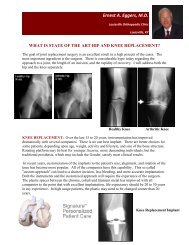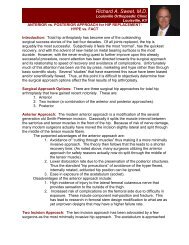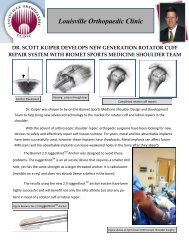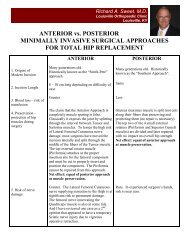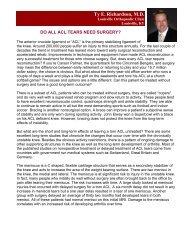FROZEN SHOULDER
FROZEN SHOULDER
FROZEN SHOULDER
Create successful ePaper yourself
Turn your PDF publications into a flip-book with our unique Google optimized e-Paper software.
<strong>FROZEN</strong> <strong>SHOULDER</strong><br />
by Scott D. Kuiper, M.D.<br />
Frozen shoulder is a relatively common condition that effects two to five percent of the population. It<br />
generally effects patients between age 40 and 60, and is slightly more common in women than men.<br />
Commonly, the patient will present with a gradual onset of pain in the shoulder and they have trouble<br />
finding the direct cause of the pain. There is no history of trauma or injury, although the pain is<br />
reported during such routine activities as reaching behind them to grab something from the backseat<br />
of a car or when reaching back to put on a coat or a shirt. Unfortunately, the pain can cause<br />
significant sleep disturbance, and is only mildly relieved by common antiinflammatory medications,<br />
such as Advil or Aleve. Over time, the shoulder becomes stiff and reaching behind one’s back or<br />
overhead becomes quite difficult, thus the name frozen shoulder (figure 1, 2). With this history of pain<br />
and now stiffness, patients generally present for medical evaluation and treatment. Many times they<br />
are seen by their primary care physician who appropriately encourages the use of antiinflammatory<br />
medication and/or starts them on a course of physical therapy, which may help the patient in regards<br />
to improving their range of motion and decreasing their pain levels. Unfortunately, some cases are<br />
resistant to treatment, and that is when, as orthopaedic surgeons, we see patients with these<br />
problems.<br />
Figure 1 Figure 2<br />
The patient's left shoulder shows significantly<br />
decreased ability to externally rotate.<br />
The patient’s left arm shows significant decreased ability to raise overhead,<br />
reach behind the back, or internally rotate.<br />
Adhesive capsulitis is another term for frozen shoulder, which was coined by Dr. Naviesar in 1945.<br />
Adhesive capsulitis has three phases. The first phase is the synovitis or painful phase and can last<br />
from 10 to 36 weeks. The second phase is the adhesive phase. During this phase the pain starts to<br />
subside, but the stiffness sets in. This can last 4 to 12 months if untreated. The final phase is the<br />
resolution phase and can last anywhere from 12 to 42 months with graduated spontaneous<br />
improvement.<br />
The cause of primary adhesive capsulitis is unknown or idiopathic. It is hypothesized that idiopathic<br />
primary adhesive capsulitis is an unusual cellular reaction related to growth factors and other proteins<br />
which may stimulate cells to make a protein called collagen, after an inflammatory response, which<br />
leads to scarring and contracture of the soft tissues around the shoulder (figure 3). This reaction<br />
leads to severe inflammation and swelling within the shoulder, and causes the pain associated with<br />
the disease process (figure 4). Secondary adhesive capsulitis can be related to other disease<br />
processes, most notably diabetes. Ten to thirtysix percent of diabetic patients are at risk for having a<br />
frozen shoulder at some time in adulthood, and these cases can be more resistant to treatment. A<br />
frozen shoulder can also be seen and diagnosed after cardiac surgery, cardiac catheterization, breast<br />
surgery and even surgery of the shoulder itself.
Figure 3 Figure 4<br />
2<br />
Illustration of inflammatory contractile tissue effecting<br />
the joint capsule of the shoulder.<br />
Arthroscopic picture of severely inflamed joint capsule<br />
within the shoulder.<br />
Fortunately, this problem can be treated successfully. Many times this solely involves nonsurgical<br />
treatment modalities. When the patient presents with the type of history noted above, generally a<br />
physical examination is performed, plain xrays are obtained, and sometimes laboratory blood studies<br />
are also ordered. Generally the plain xrays are normal, but they help us rule out other potential<br />
problems in the shoulder. Laboratory studies are many times normal as well, but sometimes we see<br />
associated positive laboratory values that indicate an underlying inflammatory process. An MRI is<br />
sometimes ordered, however, this is usually not to confirm the diagnosis of adhesive capsulitis, but<br />
rather to rule out other potential causes of pain in the shoulder such as rotator cuff tear or cartilage<br />
injury to the shoulder. Once the diagnosis is confirmed, we try to decide what stage the patient's<br />
frozen shoulder is in. If they are in the early, painful, synovitis phase, a tapering dose of oral<br />
prednisone is given along with an injection of cortical steroid in the shoulder to help relieve the severe<br />
inflammation. This will generally give quite miraculous relief and allows the patient to start working<br />
vigorously on therapeutic exercises to regain any motion that has been lost. Multiple studies and<br />
literature support the use of either oral or injectable cortical steroid for treatment of this problem. If<br />
the patient presents in the adhesive phase and has moderately restricted range of motion, but not<br />
severely restricted range of motion, physical therapy is generally ordered along with the routine use of<br />
antiinflammatory medication. If range of motion is severely restricted, a procedure can be performed<br />
to correct this. This procedure is called a manipulation under anesthesia, and does not involve<br />
incisions. A numbing shot is given so that the arm is numb and the patient is given a light sedative,<br />
and then the shoulder is brought through a range of motion with care so that scar tissue can be<br />
broken up allowing the patient to make much more progress in a structured physical therapy program.<br />
This has a success rate of 95 percent. A small number of resistant cases will have continued<br />
stiffness despite manipulation or they have MRI evidence suggesting other intraarticular pathology<br />
and a procedure called an arthroscopic lysis of adhesions can be performed. This procedure involves<br />
the use of a pencilsized arthroscopic camera to view the shoulder with the patient asleep. We can<br />
precisely locate the contracted and scarred tissues within the shoulder and release these under direct<br />
visualization, which helps restore range of motion to the shoulder.<br />
CONCLUSION<br />
Adhesive capsulitis or frozen shoulder is a condition that involves the gradual onset of pain and<br />
stiffness in the shoulder, which can be resistant to treatment such as rest and antiinflammatory use.<br />
Its cause is idiopathic or unknown, although it can be related to other underlying medical conditions,<br />
such as diabetes. This generally responds to aggressive physical therapy modalities, as well as the<br />
use of oral and/or injectable cortical steroids. In a small number of cases, a procedure called a<br />
manipulation under anesthesia or an arthroscopic lysis of adhesions is required for successful<br />
treatment.



